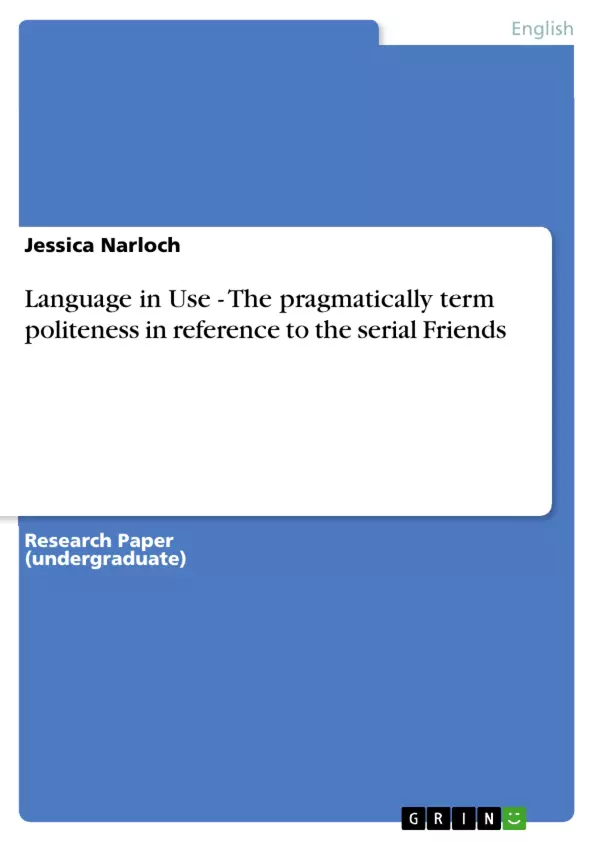In 1987 Penelope Brown and Stephen Levinson’s book Politeness. Some
Universals in Language Usage was published. They analyzed the pragmatically
term politeness and the concept of face. But it was not only them who worked on
that topic. Other persons who dealt with pragmatics too started to write books
about politeness, mostly in reference to Brown’s and Levinson’s theory. Most of
the books that were published are theoretical. Some of them include examples to
underline the expositions and to make them more understandable. But the
question is if pragmatical politeness is a phenomenon that is also noticeable in
everyday language or if it really is a more theoretical term and therefore can
hardly be practiced. To answer this question it is important to first give a definition
of the pragmatical term politeness and to analyze it by using those theoretical
books. Only then is it possible to prove if politeness is either used in everyday
language or not. After that it is necessary to analyze a medium that is
representative of daily situations. In this case one episode of the serial Friends
will be worked on to see if it includes examples of the different parts of
pragmatical politeness. When the analysis of both parts, the theoretical and the
practical, is completed the question if pragmatical politeness is a more theoretical
term or if it is noticeable in everyday language too will be answered.
Inhaltsverzeichnis (Table of Contents)
- 1. Introduction
- 2. Definition of the pragmatically term politeness
- 2.1 Introduction politeness
- 2.1.1 External factors
- 2.1.2 Internal factors
- 2.2 Politeness and face
- 2.2.1 Negative face
- 2.2.2 Positive face
- 2.3 Say nothing
- 2.4 Say something
- 2.4.1 Off record
- 2.4.2 On record
- 2.4.2.1 Positive politeness and solidarity strategy
- 2.4.2.2 Negative politeness and deference strategy
- 2.5 Pre-Sequences
- 2.6 Conclusion
- 3. Analysis of the serial Friends (Season 2, episode 21)
- 3.1 Friends The one with the Bullies
- 3.2 External factors
- 3.2.1 Socially closeness
- 3.2.2 Socially distance
- 3.3 Internal factors
- 3.4 Say nothing
- 3.5 Say something
- 3.5.1 Off record
- 3.5.2 Bald on record
- 3.5.3 Positive politeness
- 3.5.4 Negative politeness
- 3.6 Pre-sequences
- 4. Conclusion
Zielsetzung und Themenschwerpunkte (Objectives and Key Themes)
This paper aims to explore the pragmatically term politeness, particularly in relation to the concept of face, as outlined by Brown and Levinson. The paper then analyzes an episode of the popular television show Friends to see if the theoretical concepts of politeness are reflected in everyday language.- Definition of politeness and face
- External and internal factors influencing politeness
- Strategies for managing face-threatening acts
- Analysis of politeness strategies in a real-world context
- Application of theoretical concepts to everyday language
Zusammenfassung der Kapitel (Chapter Summaries)
The first chapter provides an introduction to the paper and outlines the main research question: whether pragmatical politeness is a theoretical concept or a phenomenon noticeable in everyday language. The second chapter defines the pragmatical term politeness and explores the concept of face. It distinguishes between external and internal factors influencing politeness and discusses strategies for managing face-threatening acts. The third chapter analyzes an episode of the TV show Friends to see if the theoretical concepts of politeness are reflected in everyday language. The analysis examines external and internal factors, different politeness strategies, and pre-sequences.
Schlüsselwörter (Keywords)
The primary keywords and topics of this paper include: pragmatics, politeness, face, face-threatening acts, positive politeness, negative politeness, deference, solidarity, social distance, social closeness, and the television show Friends.
- Quote paper
- Jessica Narloch (Author), 2005, Language in Use - The pragmatically term politeness in reference to the serial Friends, Munich, GRIN Verlag, https://www.grin.com/document/186301



